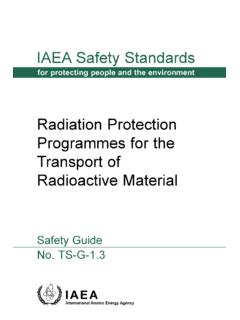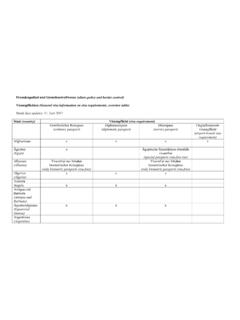Transcription of February 2011 - WHO
1 IHR CORE CAPACITY MONITORING FRAMEWORK:Checklist and Indicatorsfor Monitoring Progress in the Development of IHR Core Capacities in States PartiesInternational health Regulations CoordinationWHO/HSE/ health REGULATIONS (2005) February 2011 IHR CORE CAPACITY MONITORING FRAMEWORK:Checklist and Indicatorsfor Monitoring Progress in the Development of IHR Core Capacities in States PartiesWHO/HSE/ health REGULATIONS (2005) February 2011 world health organization 2011 All rights designations employed and the presentation of the material in this publication do not imply the expression of any opinion whatsoever on the part of the world health organization concerning the legal status of any country, territory, city or area or of its authorities, or concerning the delimitation of its frontiers or boundaries.
2 Dotted lines on maps represent approximate border lines for which there may not yet be full agreement. The mention of specific companies or of certain manufacturers products does not imply that they are endorsed or recommended by the world health organization in preference to others of a similar nature that are not mentioned. Errors and omissions excepted, the names of proprietary products are distinguished by initial capital letters. All reasonable precautions have been taken by the world health organization to verify the information contained in this publication. However, the published material is being distributed without warranty of any kind, either express or implied.
3 The responsibility for the interpretation and use of the material lies with the reader. In no event shall the world health organization be liable for damages arising from its of ContentsACKNOWLEDGEMENTS ..3 ACRONYMS ..4 GLOSSARY ..51. Introduction .. International health Regulations (2005) Background .. Purpose and Scope.. The Process Used to Develop the Monitoring Framework .. Intended Users ..132. Objectives of Monitoring the Development and Strengthening of IHR Core Capacities ..133. Conceptual Framework for Monitoring IHR Core Capacity Strengthening ..144. organization of the Monitoring Checklist ..155. Areas to be Monitored.
4 176. Definition of Capability Levels in the Monitoring Framework ..197. Data Analysis and Interpretation of Findings .. Data Analysis .. Interpretation of Findings .. States Parties reports ..248. Outputs .. Information products .. Visualization of data ..249. Data Management at the national and global Levels ..2510. Data Management at the Global Level ..2611. Country Level Process for Collecting Data on Indicators ..26112. WHA Indicators ..2813. APPENDICES ..29 Appendix : Recommended checklist for monitoring progress of IHR core capacity development ..29 Appendix : Concepts applied in developing the checklist for monitoring IHR core capacities.
5 53 Appendix : Example of data collection form ..56 Appendix : Example of country overview of IHR core capacity development status ..57 Appendix : Example of IHR Core Capacity Monitoring Workshop outline ..58 Appendix : Example of gap analysis matrix ..61 Appendix : Comprehensive list of Indicators (28 indicators) ..62 Appendix : Criteria for the selection of indicators to be reported to the WHA (mandatory) ..642 ACKNOWLEDGEMENTSThe production of this document was coordinated by Dr. Stella Chungong, Technical Coordinator of IHR National Capacity Monitoring Team, WHO, HEADQUARTERS SURVEILLANCE WORKING GROUP MEMBERSDr. Stella Chungong, Dr.
6 Rajesh Sreedharan, Dr. Jun Xing, Dr. Bernardus Ganter, Dr. Max Hardiman, Mr. Bruce Plotkin, Ms. Riik ka Koskenmaki, Dr. Daniel Menucci, Ms. Anouk Berger, Dr. Sebastien Cognat, Mr. John Rainford, Ms. Asiya Odugleh-Kolev, Dr. Dominique Legros, Dr. Angela Merianos, Dr. May Chu, Dr. Veronique Thouvenot, Ms. Kathy O Neill, Dr. Jonathan Abrahams, Dr. Heather Papowitz, Dr. Kersten Gutschmidt, Dr. Zhanat Carr, Ms. Jennifer Bishop, Dr. Celine Gossner, Dr. Bernadette Abela, Dr. Andrea Ellis, Mr. Dominique Metais, Dr. Gu na l REGIONAL OFFICESWHO Regional Office for Africa: Dr. Florimond Tshioko, Dr. Adamou Yada, Dr.
7 Wondimagegnehu Alemu, Dr. Louis Ouedraogo, Dr. Fernando Da Silveira, Dr. Ali Yahaya, Dr. Peter Regional Office for the Americas: Dr. Marlo Libel, Dr. Carmen Regional Office for the Eastern Mediterranean Region: Dr. Hassan El Bushra, Dr. Martin Opoka, Dr. Manmur Malik, Dr. John Regional Office for Europe: Dr. Roberta Andragetti, Dr. Kivi Regional Office for South-East Asia: Dr. Suzanne Westman, Dr. Ayana Yeneabat, Dr. Augusto Regional Office for the Western Pacific: Dr. Kasai Takeshi, Dr. Ailan Li, Ms. Amy INSTITUTIONSThe U. S. Centers for Disease Control and Prevention, Atlanta: Dr. Mike St Louis, Dr. Ramesh Krishnamurthy, Dr.
8 Scott McNabb, Dr. Tadesse Wuhib, Dr. Helen Perry, Dr. Robert Pinner, Dr. Ray Arthur, Dr. Goldie Centre for Epidemiology and Population health , Australian National University, Australia: Dr. Mahomed of Public health and health Sciences, University of Massachusetts: Ms. Martha European Center for Disease Control and Prevention, Stockholm, Dr. Denis National Institute of Infectious Diseases: Dr. Kiyosu deVeille Sanitaire, France: Dr. Mark African Field Epidemiology Network: Dr. Monica EXPERT GROUP MEETING MEMBERSN umerous consultations were held with technical experts who are all gratefully acknowledged, from WHO Member States (Brazil, Canada, the Democratic Republic of the Congo, France, Georgia, Japan, Kenya, Lebanon, the Philippines, Thailand, Uganda, Yemen and the United States of America), regional offices and partner STATESThe world health organization (WHO) is grateful to the following Member States for participating in the field-testing of this document.
9 Bahrain, Cambodia, Canada, China, Egypt, Ghana, India, the Lao People s Democratic Republic, Nepal, Switzerland and WHO Regional Office for the AmericasICAO International Civil Aviation OrganizationIHR International health Regulations (2005)INFOSAN International Food Safety Authorities NetworkIPC Infection prevention and controlMoH Ministry of HealthNFP National Focal PointNGO Non-governmental organizationPAHO Pan American health OrganizationPoE Points of entryRRT Rapid response teamsSOP Standard operating procedureSWOT Strengths, weaknesses, opportunities and threats analysisUN United NationsWHA world health AssemblyWHO world health Organization45 GLOSSARYT erms and NB.
10 The following definitions have been provided for words and phrases found in the text and as they relate to their use in the context of this tool only, and may differ from those used in other , baggage, cargo, containers, conveyances, goods, postal parcels or human remains that are infected or contaminated, or carry sources of infection or contamination, so as to constitute a public health of a set of specific elements or characteristics that reflect the level of performance or achievement of a specific maintenance of safe conditions in biological research to prevent harm to workers, non-laboratory organisms and the levelindicates how far State Party has progressed towards attaining a given indicator, component and core definitiona case definition is a set of diagnostic criteria for use during surveillance and outbreak investigations that must be fulfilled for an individual to be regarded as a case of a particular disease for the purposes of surveillance and outbreak investigations.











